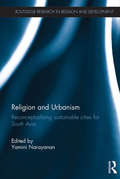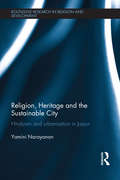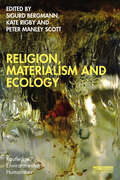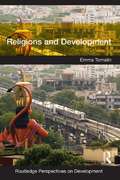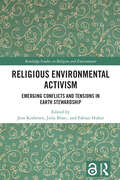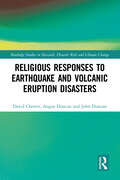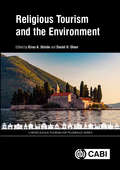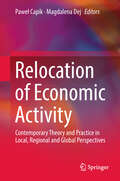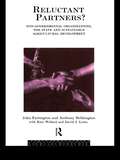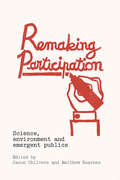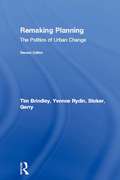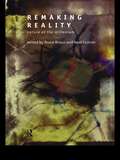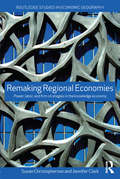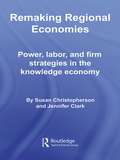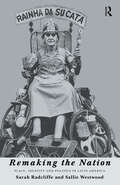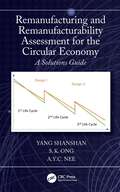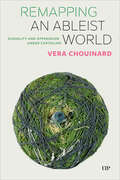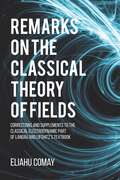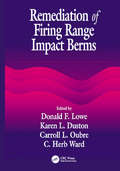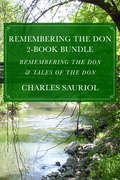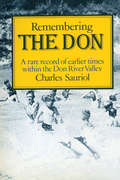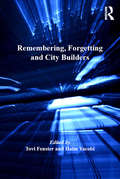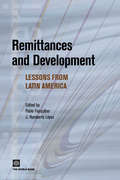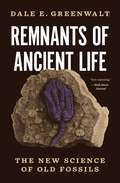- Table View
- List View
Religion and Urbanism: Reconceptualising sustainable cities for South Asia (Routledge Research in Religion and Development)
by Yamini NarayananConceptions of 'sustainable cities' in the pluralistic and multireligious urban settlements of developing nations need to develop out of local cultural, religious and historical contexts to be inclusive and accurately respond to the needs of the poor, ethnic and religious minorities, and women. Religion and Urbanism contributes to an expanded understanding of 'sustainable cities' in South Asia by demonstrating the multiple, and often conflicting ways in which religion enables or challenges socially equitable and ecologically sustainable urbanisation in the region. In particular, this collection focuses on two aspects that must inform the sustainable cities discourse in South Asia: the intersections of religion and urban heritage, and religion and various aspects of informality. This book makes a much-needed contribution to the nexus between religion and urban planning for researchers, postgraduate students and policy makers in Sustainable Development, Development Studies, Urban Studies, Religious Studies, Asian Studies, Heritage Studies and Urban and Religious Geography.
Religion, Heritage and the Sustainable City: Hinduism and urbanisation in Jaipur (Routledge Research in Religion and Development)
by Yamini NarayananThe speed and scale of urbanisation in India is unprecedented almost anywhere in the world and has tremendous global implications. The religious influence on the urban experience has resonances for all aspects of urban sustainability in India and yet it remains a blind spot while articulating sustainable urban policy. This book explores the historical and on-going influence of religion on urban planning, design, space utilisation, urban identities and communities. It argues that the conceptual and empirical approaches to planning sustainable cities in India need to be developed out of analytical concepts that define local sense of place and identity. Examining how Hindu religious heritage, beliefs and religiously influenced planning practices have impacted on sustainable urbanisation development in Jaipur and Indian cities in general, the book identifies the challenges and opportunities that ritualistic and belief resources pose for sustainability. It focuses on three key aspects: spatial segregation and ghettoisation; gender-inclusive urban development; and the nexus between religion, nature and urban development. This cutting-edge book is one of the first case studies linking Hindu religion, heritage, urban development, women and the environment in a way that responds to the realities of Indian cities. It opens up discussion on the nexus of religion and development, drawing out insightful policy implications for the sustainable urban planning of many cities in India and elsewhere in South Asia and the developing world.
Religion, Materialism and Ecology (Routledge Environmental Humanities)
by Sigurd Bergmann, Kate Rigby and Peter Manley ScottThis timely collection of essays by leading international scholars across religious studies and the environmental humanities advances a lively discussion on materialism in its many forms. While there is little agreement on what ‘materialism’ means, it is evident that there is a resurgence in thinking about matter in more animated and active ways. The volume explores how debates concerning the new materialisms impinge on religious traditions and the extent to which religions, with their material culture and beliefs in the Divine within the material, can make a creative contribution to debates about ecological materialisms. Spanning a broad range of themes, including politics, architecture, hermeneutics, literature and religion, the book brings together a series of discussions on materialism in the context of diverse methodologies and approaches. The volume investigates a range of issues including space and place, hierarchy and relationality, the relationship between nature and society, human and other agencies, and worldviews and cultural values. Drawing on literary and critical theory, and queer, philosophical, theological and social theoretical approaches, this ground-breaking book will make an important contribution to the environmental humanities. It will be a key read for postgraduate students, researchers and scholars in religious studies, cultural anthropology, literary studies, philosophy and environmental studies.
Religions and Development (Routledge Perspectives on Development)
by Emma TomalinReligion has been excluded from development studies for decades. Religious traditions have contributed greatly towards development work, yet major international players have tended to ignore its role. Recent years have shown a noticeable shift in development policy, practice and research to recognize religion as a relevant factor. This text provides a comprehensive insight into different approaches towards the understanding the relationships between religions and development studies, policy and practice. It guides readers through current debates, presenting, explaining and critically evaluating a broad range of literature and locating it within a theoretical context. The text explores the role of religion within development, from positive contributions, such as the important role that many ‘faith-based organizations’ play in education or health care, to more complicated and contested notions of impact, such as religiously inspired violence or gender inequality. The book begins with three background chapters, outlining the relevance of religions for development studies, policy and practice, and introducing the reader to the study of ‘development’ and of ‘religions’. Following these, the focus then shifts to examine a number of thematic areas, including religion, gender and development, and the implications of the ‘rise of religion’ for mainstream development studies, policy and practice in the 21st century. Each chapter contains a range of features to assist undergraduate learning, including learning objectives for each chapter, discussion of key concepts, summaries, discussion questions, further reading and websites. The book also contains over sixty boxed case studies to provide further definition, explanation, and examples of the interactions between religions and development globally. This innovative text presents religions as something that can both obstruct and aid development, encouraging readers to engage critically with the multiple ways that religion impacts on both the conceptualization of development as well the resulting project interventions. This will be of interest to undergraduate, postgraduate students and scholars interested in religious studies, development studies, and the broader study of societies and cultures.
Religious Environmental Activism: Emerging Conflicts and Tensions in Earth Stewardship (Routledge Studies in Religion and Environment)
by Jens Koehrsen Julia Blanc Fabian HuberThis volume explores how religious and spiritual actors engage for environmental protection and fight against climate change. Climate change and sustainability are increasingly prominent topics among religious and spiritual groups. Different faith traditions have developed "green" theologies, launched environmental protection projects and issued public statements on climate change. Against this background, academic scholarship has raised optimistic claims about the strong potentials of religions to address environmental challenges. Taking a critical stance with regard to these claims, the chapters in this volume show that religious environmentalism is an embattled terrain. Tensions are an inherent part of religious environmentalism. These do not necessarily manifest themselves in open clashes between different parties but in different actions, views, theologies, ambivalences, misunderstandings, and sometimes mistrust. Keeping below the surface, these tensions can create effective barriers for religious environmentalism. The chapters examine how tensions are manifested and dealt with through a range of empirical case studies in various world regions. Covering different religious and spiritual traditions, they reflect on intradenominational, interdenominational, interreligious, and religious-societal tensions. Thereby, this volume sheds new light on the problems that religions face when they seek to take an active role in today’s societal challenges.
Religious Responses to Earthquake and Volcanic Eruption Disasters (Routledge Studies in Hazards, Disaster Risk and Climate Change)
by John Duncan Angus Duncan David ChesterThis book argues that, although secular and religious perspectives on disasters have often conflicted, today there are grounds for believing that the world’s major faiths have much to contribute to the processes of post-disaster recovery and future disaster risk reduction (DRR).It seeks to demonstrate how contemporary dialogues between theologians, disaster scholars and policymakers are defining new ways of working together. These explore how the resources of religious communities, e.g. buildings, human resources and finance, may be used to foster successful policies of DRR, particularly in the aftermath of earthquakes and volcanic eruptions. Musing on the relationships between religion and disasters has occurred for millennia and has affected many societies worldwide. In societies where the world’s major religions – Buddhism, Christianity, Hinduism, Islam, Judaism and Shinto – have been and remain dominant, attempting to find supernatural explanations for disasters has occurred throughout history and there have been many theologies seeking to explain why people suffer losses. It is argued that developments both within these traditions of faith and in how disasters are understood by the hazard research community of researchers and planners have allowed a new modus vivendi to emerge which emphasises both a recognition of religious worldviews by academic writers and disaster planners on the one hand, and a desire by people of faith and their leaders to be more fully committed to the goals of DRR.The book will appeal to those who are interested in the interface between disasters and theology across the principal religions of the world. This includes researchers and students in geology, geography, theology and religious studies. It will also be useful for specialist academic audience and the educated general reader.
Religious Tourism and the Environment (CABI Religious Tourism and Pilgrimage Series)
by Kiran A. Shinde and Daniel H. OlsenThe remarkable growth in religious tourism across the world has generated considerable interest in the impacts of this type of tourism. Focusing here on environmental issues, this book moves beyond the documentation of environmental impacts to examine in greater depth the intersections between religious tourism and the environment. Beginning with an in-depth introduction that highlights the intersections between religion, tourism, and the environment, the book then focuses on the environment as a resource or generator for religious tourism and as a recipient of the impacts of religious tourism. Chapters included discuss such important areas as theological views, environmental responsibility, and host perspectives. Covering as many cultural and environmental regions as possible, this book provides: -An in-depth yet holistic view of the relationships between religious tourism and the environment; -A conceptual framework that goes beyond listing potential environment impacts; -A strong focus on explaining the universality of the deeper environmental issues surrounding sacredness and sacred places; -A discussion of the role of disease and health-related issues at mass religious gatherings. From a global writing team and featuring case studies spanning Europe and Asia, this book will be of great interest to researchers and students of tourism and religious studies, as well as those studying environmental issues.
Relocation of Economic Activity: Contemporary Theory and Practice in Local, Regional and Global Perspectives
by Paweł Capik Magdalena DejThis timely volume provides a thorough analysis of current trends in location and relocation of economic activity globally, regionally and locally. Using robust empirical material this book offers a multidisciplinary, comprehensive overview, critique and extension of long-established theories underpinning patterns of firm (re)location. It explores dominant trends in the mobility and relocation of industries and firms, examines the factors guiding such trends and evaluates their consequences in both developed and emerging economies in Europe, Asia and Latin America.This book will be appreciated by diverse audiences. Geography and regional science researchers of ‘economic activity location’ can engage with the critical appraisal of key theoretical concepts and an analysis of recent empirical data. Students of human and economic geography, planning, regional development, and global supply chain management in senior years of undergraduate programmes and completing postgraduate degrees will appreciate the accessible language, multiple examples and graphical illustrations of theoretical frameworks underpinning location and relocation of firms and industries, and its consequences. Practitioners, including local and regional policy makers and location consultants will enjoy the comparative discussion of solutions and practices adopted in localities, regions and countries as diverse as China, Brazil, The Netherlands and Poland.
Reluctant Partners? Non-Governmental Organizations, the State and Sustainable Agricultural Development (Non-Governmental Organizations series)
by Anthony Bebbington David J. Lewis John Farrington Kate WellardReluctant Partners? combines comprehensive empirical insights into NGOs' work in agriculture with wider considerations of their relations with the State and their contribution to democratic pluralism. This overview volume for the Non-Governmental Organizations series contextualizes and synthesizes the case study material in the three regional volumes on Africa, Asia and Latin America, where over sixty specially commissioned case studies of farmer-participatory approaches to agricultural innovation are presented.Specific questions are raised. How good/bad are NGOs at promoting technological innovation and addressing contraints to change in peasant culture? How effective are NGOs at strengthening local organizations? How do/will donor pressures influence NGOs and their links to the State?
Remaking Participation: Science, Environment and Emergent Publics
by Matthew Kearnes Jason ChilversChanging relations between science and democracy – and controversies over issues such as climate change, energy transitions, genetically modified organisms and smart technologies – have led to a rapid rise in new forms of public participation and citizen engagement. While most existing approaches adopt fixed meanings of ‘participation’ and are consumed by questions of method or critiquing the possible limits of democratic engagement, this book offers new insights that rethink public engagements with science, innovation and environmental issues as diverse, emergent and in the making. Bringing together leading scholars on science and democracy, working between science and technology studies, political theory, geography, sociology and anthropology, the volume develops relational and co-productionist approaches to studying and intervening in spaces of participation. New empirical insights into the making, construction, circulation and effects of participation across cultures are illustrated through examples ranging from climate change and energy to nanotechnology and mundane technologies, from institutionalised deliberative processes to citizen-led innovation and activism, and from the global north to global south. This new way of seeing participation in science and democracy opens up alternative paths for reconfiguring and remaking participation in more experimental, reflexive, anticipatory and responsible ways. This ground-breaking book is essential reading for scholars and students of participation across the critical social sciences and beyond, as well as those seeking to build more transformative participatory practices.
Remaking Planning: The Politics of Urban Change
by Gerry Stoker Yvonne Rydin Tim BrindleyRemaking Planning challenges the common misconception that planning under the Conservative government has been dismantled and abandoned to market forces. This new edition of a very well received text brings the original study up to date with an analysis of how planning in the 1990s has responded to continuing economic restructuring, political fragmentation and social change, and developed a new awareness of uncertainty and risk. The book illustrates how planning remains as a never-ending attempt to reconcile the demands of economic efficiency with those of democratic legitimacy.
Remaking Reality: Nature at the Millenium
by Noel Castree Bruce BraunThis book rejects apocalyptic pronouncements that the end of the millenium represents the 'end' of nature as well. Remaking Reality brings together contributors from across the human sciences who argue that a notion of 'social nature' provides great hope for the future. Applying a variety of theoretical approaches to social nature, and engaging with debates in politics, science, technology and social movements surrouding race, gender and class, the contributors explroe important and emerging sites where nature is now being remade with considerable social and ecological consequences. The essays are organised around two themes: 'capitalising and envisioning nature' and 'actors, networks and the politics of hybridity'. An afterword by Neil Smith reflects on the problems and possibilities of future names.For critics and activists alike, Remaking Reality provides essential theoretical and political tools to rethink environmentalism and progressive social natures for the twenty first century.
Remaking Regional Economies: Power, Labor and Firm Strategies (Routledge Studies In Economic Geography Ser.)
by Jennifer Clark Susan ChristophersonWinner of the 2009 Regional Studies Association Best Book Award! Since the early 1980s, the region has been central to thinking about the emerging character of the global economy. In fields as diverse as business management, industrial relations, economic geography, sociology, and planning, the regional scale has emerged as an organizing concept for interpretations of economic change. This book is both a critique of the "new regionalism" and a return to the "regional question," including all of its concerns with equity and uneven development. It will challenge researchers and students to consider the region as a central scale of action in the global economy, and at the core of the book are case studies of two industries that rely on skilled, innovative, and flexible workers - the optics and imaging industry and the film and television industry. Combined with this is a discussion of the regions that constitute their production centers. The authors’ intensive research on photonics and entertainment media firms, both large and small, leads them to question some basic assumptions behind the new regionalism and to develop an alternative framework for understanding regional economic development policy. Finally, there is a re-examination of what the regional question means for the concept of the learning region.This book draws on the rich contemporary literature on the region but also addresses theoretical questions that preceded "the new regionalism." It will contribute to teaching and research in a range of social science disciplines and this new paperback edition will also make the book more accessible to students and researchers in those disciplines, those individuals who will influence the re-structuring economies of the 21st century.
Remaking Regional Economies: Power, Labor, and Firm Strategies in the Knowledge Economy (Routledge Studies in Economic Geography)
by Jennifer Clark Susan ChristophersonSince the early 1980s, the region has been central to thinking about the emerging character of the global economy. In fields as diverse as business management, industrial relations, economic geography, sociology, and planning, the regional scale has emerged as an organizing concept for interpretations of economic change. This book is both a critique of the "new regionalism" and a return to the "regional question," including all of its concerns with equity and uneven development. It will challenge researchers and students to consider the region as a central scale of action in the global economy. At the core of the book are case studies of two industries that rely on skilled, innovative, and flexible workers - the optics and imaging industry and the film and television industry. Combined with this is a discussion of the regions that constitute their production centers. The authors’ intensive research on photonics and entertainment media firms, both large and small, leads them to question some basic assumptions behind the new regionalism and to develop an alternative framework for understanding regional economic development policy. Finally, there is a re-examination of what the regional question means for the concept of the learning region. This book draws on the rich contemporary literature on the region but also addresses theoretical questions that preceded "the new regionalism." It will contribute to teaching and research in a range of social science disciplines.
Remaking the Nation: Identity and Politics in Latin America
by Sarah Radcliffe Sallie Westwood Dr Sallie WestwoodRemaking the Nation presents new ways of thinking about the nation, nationalism and national identities. Drawing links between popular culture and indigenous movements, issues of 'race' and gender, and ideologies of national identity, the authors draw on their work in Latin America to illustrate their retheorisation of the politics of nationalism. This engaging exploration of contemporary politics in a postmodern, post new-world-order uncovers a map of future political organisation, a world of pluri-nations and ethnicised identities in the ever-changing struggle for democracy.
Remanufacturing and Remanufacturability Assessment for the Circular Economy: A Solutions Guide
by A.Y.C. Nee Yang Shanshan S. K. OngThis book presents decision support tools that can be used in the early design stage to analyze the feasibility of a product and its components for remanufacturing. It also covers how to design a product specifically for remanufacturing and offers supporting case studies. This is a comprehensive solutions guide for remanufacturing decision-making. The book illustrates an approach that can be used at the product End-of-Life (EOL) stage to generate optimized recovery plans for the returned products. Opportunities for Industry 4.0 to support remanufacturing along with case studies are included to showcase the decision-making tools. Remanufacturing and Remanufacturability Assessment for the Circular Economy: A Solutions Guide will be of interest to practitioners, business professionals, and researchers that work in the industrial and manufacturing sectors. Those involved with supply chain management and advanced technologies associated with Industry 4.0, sustainability, and integrated techniques of circular supply chains will also find this book very useful.
Remapping an Ableist World: Disability and Oppression under Capitalism
by Vera ChouinardRemapping an Ableist World examines the forces shaping our lives in an able capitalist world. It draws on examples including human enhancement and the organ trade to illustrate connections between able capitalist ways of life, impairment, disability, and oppression. The book addresses ableness as a regime of power and oppression intrinsic to global capitalism and, as such, a system that touches all of our lives, albeit in different ways. Vera Chouinard offers an intersectional analysis of the production of impairment and disability, drawing on autoethnographic and autobiographical methodologies, case studies of disability in the Global South and North, and comparative accounts of processes such as the uneven development of disability law. Inviting readers to rethink the causes and consequences of the ableist capitalist order in which we find ourselves, Remapping an Ableist World reminds us that for our own well-being and that of generations to comes we must forge a less destructive and more nurturing way of life.
Remarkable Plants That Shape Our World
by William Bynum Helen BynumImagine a typical morning—munching on a bowl of cereal, sipping coffee, dressing for the day, riding to work. Every moment of this common routine draws on the power of plants, and the centuries of development that brought wheat, coffee beans, cotton, and rubber—among many others—into our daily lives. <p><p>Remarkable Plants celebrates the wonder and utility of the green kingdom, taking a detailed look at how plants have shaped our world. It focuses on eighty key species and richly explores their history, highlighting their importance and bringing to light surprising stories. Organized thematically into eight sections, the book starts with “Transformers” (including rice, beans, olives) and moves through sections such as “Heal and Harm” (poppy, aloe, strychnos) and “Revered and Adored” (lotus, frankincense, rose). Each species is introduced with its common and scientific names and followed by an exploration of its cultural, historical, botanical, and symbolic associations.
Remarks on The Classical Theory of Fields: Corrections and Supplements to the Classical Electrodynamic Part of Landau and Lifshitz's Textbook
by Eliahu ComayThis book undertakes the unusual task of correcting and proposing supplements to the Landau and Lifshitz's highly celebrated textbook titled: The Classical Theory of Fields 1, which has been extraordinarily influential. Its first edition was publis
Remediation of Firing Range Impact Berms
by C. H. WardA part of the continuing effort to provide innovative in situ remediation techniques, Remediation of Firing-Range Impact Berms presents the results of a soil washing and leaching project. The demonstration set as its primary objective providing reliable, detailed performance data to evaluate the feasibility and cost of implementing a full-scale sys
Remembering the Don 2-Book Bundle: Remembering the Don / Tales of the Don
by Charles SauriolMore than just a Parkway, the Don Valley is a vital natural habitat in Toronto's city core. Naturalist Charles Sauriol was a key player in its preservation. Here Sauriol shares a history of the Don Valley, from earlier times when the Mississauga First Nation encamped along the river teaming with salmon to cottaging to the naturalists who worked to save the Don Valley. This two-book bundle includes: Remembering the Don: A Rare Record of Earlier Times Within the Don River Valley A tribute to the earlier days of the Don River Valley: Mississauga First Nation camped along a Don River teeming with salmon, red-coated militia regiments, and courageous pioneers. Tales of the Don From Scout outings in 1920 to pioneer cottaging, the author's long association with the Don makes for fascinating reading in this sequel to Remembering the Don.
Remembering the Don: A Rare Record of Earlier Times Within the Don River Valley
by Charles SauriolRemembering the Don is a tribute to the things "that used to be." Of Mississauga Indians encamped along a sprawling river teeming with salmon, red-coated Militia regiments, and courageous pioneer men and women from widely differing backgrounds. <P><P>In later times the Don Valley and the river Don were to attract a host of outstanding naturalists, authors and artists. Through their combined talents and energy, word and evidence of the history and beauty of the Don Valley spread far beyond its physical environs. <P><P>With the publication of Remembering the Don, Charles Sauriol assumes his rightful role as one of the Don Valley's greatest champions.
Remembering, Forgetting and City Builders (Re-materialising Cultural Geography Ser.)
by Haim YacobiRemembering, Forgetting and City Builders critically explores how urban spaces are designed, planned and experienced in relation to the politics of collective and personal memory construction. Bringing together case studies from North America, South Asia, Eastern Europe and the Middle East, the book analyzes how contested national, ethnic and cultural sentiments clash in planning and experiencing urban spaces. Going beyond the claim that such situations exist in many parts of the world because communities construct their 'past memories' within their current daily life and future aspirations, the book explores how the very acts of planning and urban design are rooted in the existing structures of hegemonic power. With contributors from the fields of architecture, geography, planning, anthropology and sociology, urban studies and cultural studies, the book provides a rich, interdisciplinary view into the conflicts over memory and belonging which are spatially expressed and mediated through the official planning apparatus.
Remittances and Development
by Pablo Fajnzylber J. Humberto LopezThe editors (senior economists at the Office of the Chief Economist for the Latin America and the Caribbean Region, World Bank) present ten papers that analyze cross-country panel data and household surveys for 11 Latin American countries in order to assess the economic effects of worker remittance flows for development. Separately, the collections papers discuss patterns and determinants of migration and remittances, remittances and poverty levels, remittances and household behavior, remittances and recipient countries' financial development, the impact of public transfers on remittances, remittances and real exchange rates, remittance flows and system security, and the role of complementary policies for remittances and growth. Annotation ©2008 Book News, Inc. , Portland, OR (booknews. com)
Remnants of Ancient Life: The New Science of Old Fossils
by Dale E. GreenwaltThe revolution in science that is transforming our understanding of extinct lifeWe used to think of fossils as being composed of nothing but rock and minerals, all molecular traces of life having vanished long ago. We were wrong. Remnants of Ancient Life reveals how the new science of ancient biomolecules—pigments, proteins, and DNA that once functioned in living organisms tens of millions of years ago—is opening a new window onto the evolution of life on Earth.Paleobiologists are now uncovering these ancient remnants in the fossil record with increasing frequency, shedding vital new light on long-extinct creatures and the lost world they inhabited. Dale Greenwalt is your guide to these astonishing breakthroughs. He explains how ancient biomolecules hold the secrets to how mammoths dealt with the bitter cold, what colors dinosaurs exhibited in mating displays, how ancient viruses evolved to become more dangerous, and much more. Each chapter discusses different types of biomolecules and the insights they provide about the physiology, behavior, and evolution of extinct organisms, many of which existed long before the age of dinosaurs.A marvelous adventure of discovery, Remnants of Ancient Life offers an unparalleled look at an emerging science that is transforming our picture of the remote past. You will never think of fossils in the same way again.
